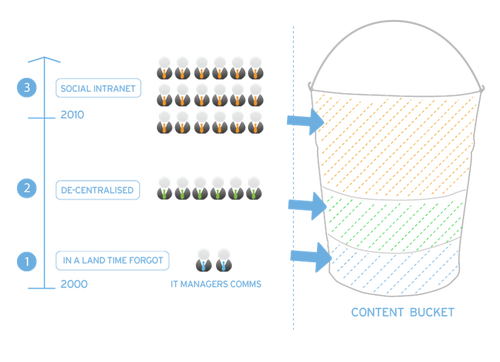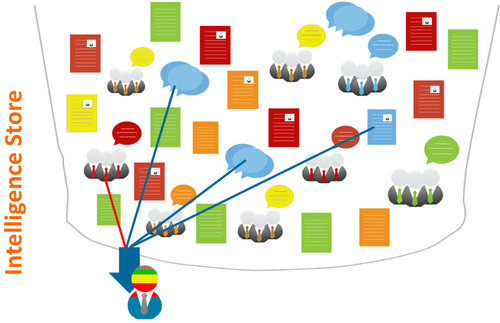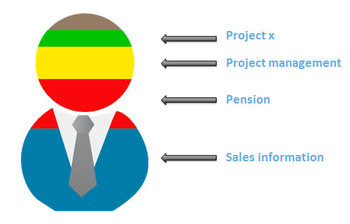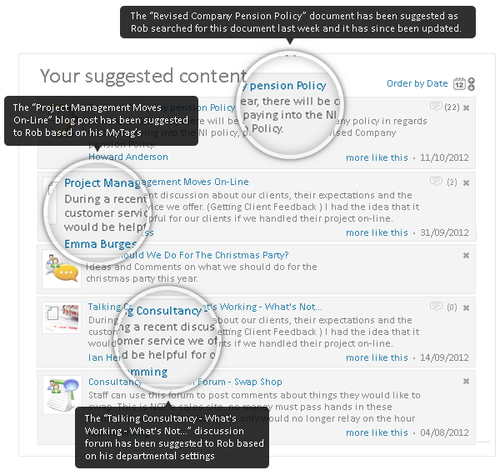Content Should Find People: An Essential Requirement for Any Social Intranet
Intranet Evolution
It is evident that over the last decade, intranets have dramatically changed and adapted, according to business requirements. The biggest development of intranet evolution is that it’s easier for anyone to upload content, which is great but has left the modern day intranet flooded with content.
Ten years ago, IT managers had sole responsibility for adding content to the intranet, limiting the frequency of content being added – if you had a busy IT team you can bet your intranet was not updated that often. Communication was top down – “management knows best.”
Over the past few years, the adding of content has become increasingly de-centralised as ‘Intranet Champions’ have been introduced in various departments in the workplace, such as marketing, finance and HR. Adding content became less of a technical nightmare.
As the ‘social‘ intranet continues to evolve, it is not uncommon to have hundreds, if not thousands, of people contributing to intranet content on a daily basis. Staff actively write blogs, comment on documents, ‘Like’, ‘Share’ and post status updates – which is fantastic but this has resulted in a huge volume of content on our intranets that is not always relevant to everybody.

In a world where time is critical and even one extra click can deter users from continuing with a process, the demand for accurate and relevant content is crucial. It’s imperative that users find the information they are looking for on the intranet quickly and that what they do find is helping them to ‘get work done’.
You don’t know what you don’t know!
We are intelligent beings – we can filter out noise that takes place in the workplace and focus on content that is relevant. As you sit at your desk you hear conversations subconsciously and then focus in on the things you hear that are relevant to you. How many times have you heard someone mention something in your office that is relevant to a project you’re working on and has a direct effect on your work? That “I wish I’d have known that yesterday!” moment.
For example, there maybe three conversations taking place close to you. One, a general conversation about football results last night, another is a general discussion in the marketing department about new brand guidelines and another discussing how a product launch date is being changed. You have a meeting with a customer tomorrow to discuss the product launch, you now need to inform the customer of this change in date.
However, how do you do this when these conversations are happening in many different office locations around the world? Wouldn’t it be great if you had the ability to hone in on the conversations that matter to you, no matter where you are?
“Personalisation” of your intranet could help with this. For example, setting up your intranet homepage so that it is relevant for specific user groups depending on their job role, interests etc. is a step in the right direction and might reduce the level of content noise but ultimately this personalisation is likely to fail because to personalise, you have to constantly make manual changes to keep things relevant. It’s another on-going project that people have to keep up to date.
The reality is, in a large organisations there are just too many people who have different needs:
- Different job roles
- Different skills
- Different ways of accessing the intranet
- Different interests
- Different knowledge gaps
- Different languages
These needs can’t be controlled with personalisation! Who has the time to constantly update their preferences? How many people can honestly say they personalise their Google homepage? And if you do – how often do you update it to reflect your current interests and circumstances?
Wouldn’t it be better if an intranet understood what you were interested in and automatically delivered this content to you? Just like Google intelligently gives you content it knows is most relevant to you, rather than relying on you to update your preferences -which let’s face it will never happen!
For a modern day intranet to become essential to an organisation’s success and to help staff get work done, it must be able to look at your connections, interactions, intranet behaviour and profile data and from this information, construct a Profile DNA that is unique to each intranet user.
From looking at your Profile DNA, an intranet should be able to intelligently push relevant content to the user.

For example – Rob is pushed relevant information based on his profile DNA. Each bit of content he is pushed has a weight to it, which matches his Profile DNA to the Content DNA.

John, who sits next to Rob gets completely different content pushed to him based on his profile DNA. They are pushed this information in a number of different ways including emails and Interact Suggests.
What I am saying is nothing new in terms of what we are seeing elsewhere in our lives. This intelligence is already occurring on the web every day – Google pushes information to you based on the location you are in and your past searches, Facebook suggests people you may know and displays tailored adverts to you. Amazon shows you things you may be interested in buying, based on your search history and past purchases.

Even supermarkets monitor your shopping habits and send you discount vouchers – pulling you into the store. People won’t specifically go to find out that there’s 25p off coffee but if they get a voucher in the post, it may encourage them to go!
We should expect this intelligence within our intranet. As the social intranet is becoming a more critical requirement of companies across the world, then why can’t we expect it to tailor content to our behaviours and requirements? We need to get answers to our questions quickly and find out about documents or conversations that are essential to do our job more effectively.
If LinkedIn or Twitter can tell us about people, documents or conversations that might be helpful to our jobs, then why can’t intranets do the same?
